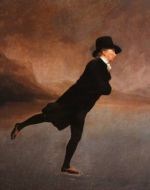
Revd Dr Robert Walker Skating on Duddingston Loch, (c.1795) by Sir Henry Raeburn
copyright National Gallery of Scotland
Although now within the boundary of the City of Edinburgh, Duddingston retains the feel of a small village. This cache will take you round a short circuit of the village. Duddingston derives its name from the family name of a Norman Knight called Dodin, who lived in the reign of David 1. Previously it was known by the ancient Celtic name of Treverlen.
Park in the car park just within the gates of Holyrood Park at the coordinates given. Behind the carpark are remains of ancient terraces on the hill. In 1778, Bronze age artefacts were found in Duddingston Loch, and are now held by the National Museum of Scotland. You can admire Duddingston Loch now, but you will be returning here later.
The Sheep Heid Inn
Walk to N55 56.521 W003 08.922. Go up the lane towards Duddingston Village from the carpark. You will find an information plaque opposite The Sheep’s Heid. Find the date that the plaque was erected 19AB. The Sheep’s Head Inn claims to be ‘Scotland’s Oldest Bar’, established in 1360. You may wish to visit it for refreshments; there is a garden at the back. Bonnie Prince Charlie’s Cottage
Walk down The Causeway and around the corner to N55 56.549 W003 08.718. You will find the cottage where, in 1745, Prince Charles Edward Stuart held his Council of War before the Battle of Prestonpans. A friend of mine lives in part of this cottage, and it was a visit to collect something from her that was the inspiration for this cache. On the main front door below the stone inscription, find the number of the house on a small brass plaque. Make this number C.
Duddingston Kirk
Continue to the end of the road, turn right and right again. Passing Duddingston Manse, you will arrive at Duddingston Kirk at N55 56.483 W003 08.919. The church was built in the early part of the 12th century, by the monks of Kelso and local stonemasons. The hexagonal Watch Tower was built in 1824, where two church elders were required to keep watch for 21 days after a burial, to stop graverobbers from digging up bodies and selling them to members of the medical profession for dissection.
Rest a while on the stone seat and make note of the inscription on it. There are two lines of words. Using A=1, B=2 etc, find the number for the seventh letter of the first line = D.
How many large geese are in the carved picture? Make this E. On the other side of the gates to the church, are the ‘louping-on-stane’ and ‘joug’s collar’. The former consists of four steps, to allow churchgoers to mount and dismount from their horses. The latter is an iron collar on a chain attached to the wall, and was used to humiliate any sinners, whose offences might have included blasphemy, adultery, drunkenness and failure to attend church regularly. Up to 1833 the Kirk Session of the local Parish had the legal authority to manage local justice of people living within the Parish. This joug’s collar is one of a few examples left in Scotland.
On the other side of the road, you will see a large square stone carving on the wall. The date beside ‘Dodin Toun Kirk’ is 112F.
The creator of the carving is T Chalk, and beside his name are two numbers of the date it was created. Make these GH.
Duddingston Loch
Continue down the wee hill back towards the loch. The loch is famous for being the setting of Sir Henry Raeburn’s ‘The Rev Walker Skating on Duddingston Loch’, which hangs in the National Gallery of Scotland. For hundreds of years it has been popular for skating and curling. Today it is a popular spot for bird watching, and you are likely to have to navigate past the colony of Greylag and Canada geese, ducks and swans, as you trod the paths (and mind the poo!). Otters have also been spotted here recently, for the first time in over 100 years. On the southern shore is the largest area of reed-beds in the Lothians.
The cache can be found at N55 5B. D(C-2)E W003 0G. FH(A-1). Please rehide it carefully as this is a popular place and the hiding spot is rather exposed.
You can check your answers for this puzzle on GeoChecker.com.